Estuary-Tidal Residual Water Level Forecasting Method Based on Variational Mode Decomposition and Back Propagation Neural Network
Abstract
1. Introduction
2. Data and Method
2.1. Research Areas and Data
- (1)
- The Sabine Pass tidal gauge station is located in the southeastern part of Texas, at the confluence of Sabine Lake and the Gulf of Mexico, close to the Louisiana border. It is a typical estuarine wetland environment, characterized by low-lying terrain influenced by the Mississippi River delta plain.
- (2)
- The Pilottown tidal gauge station is located at the southernmost tip of the Mississippi River Delta in Louisiana, close to the river’s mouth. This station is situated in a highly dynamic sedimentary environment, surrounded by ever-changing river channels, swamps, and lagoons, with very low terrain significantly affected by river sedimentation and erosion.
- (3)
- The Saint-Nazaire tidal gauge station is located on the southern bank of the Loire estuary on the west coast of France, adjacent to the Bay of Biscay. The station is situated in the open waters of the eastern Atlantic, affected by both Atlantic swells and estuarine topography.
- (4)
- The Saint-Malo tidal gauge station is located on the northern coast of the Brittany region in France, at the junction of the English Channel and Saint-Malo Bay. The narrow topography of the bay and the resonance effect enhance the tidal amplitude.
2.2. Tide Harmonic Analysis
2.3. Variational Modal Decomposition
2.4. Back Propagation Neural Network
2.5. Evaluation Indicators
2.6. Processing Flow of VMD-BPNN
- (1)
- Conduct tidal harmonic analysis on the water level data of the tide gauge station.
- (2)
- Use VMD and EEMD methods to decompose the sequence, resulting in several IMFs and a residual component.
- (3)
- Analyze the spectral characteristics of each component.
- (4)
- Finally, train these components using a back propagation neural network and forecast backward. The forecasted results of each component are added to obtain the forecasted value of the residual water level.
3. Results and Discussion
3.1. VMD Experimental Analysis
- (1)
- From Figure 5, it can be seen that the residual water level signal obtained multiple IMFs after EEMD. Each mode exhibits a certain adaptability in the time–frequency domain, but there is a modal aliasing phenomenon in the high-frequency part, manifested as overlapping frequency bands of adjacent modes, and some IMFs contain residual noise. This indicates that while EEMD suppresses the instability of single EMD through noise perturbation, its decomposition results are still affected by the number of ensemble averages and the amplitude of noise, which may lead to the loss of detailed information.
- (2)
- As shown in Figure 6, VMD achieves accurate separation of signals through preset modal numbers and constrained variational problems. The amplitude and frequency distribution of low-frequency and high-frequency modes show significant differences, indicating that VMD has stronger robustness in processing non-stationary signals, effectively preserving local features of the signal.
- (3)
- Comparing Figure 5 and Figure 6, it can be observed that, compared to EEMD, VMD adaptively optimizes the central frequency and bandwidth of modes through a variational framework, avoiding the modal uncertainty introduced by noise-assisted methods. Furthermore, it can still accurately separate tidal multi-scale periodic components under strong noise interference, with significantly better physical interpretability and resistance to modal aliasing than EEMD.
- (4)
- From Figure 7, it can be seen that each IMF of EEMD exhibits a multi-peak distribution characteristic in the frequency domain, reflecting the complex periodic fluctuations in the signal (such as tidal and runoff superposition). Some IMFs show overlapping spectra, manifested as overlapping peaks in adjacent frequencies or noise interference. The main frequency components are identifiable, but background noise is quite pronounced.
- (5)
- As indicated in Figure 8, the frequency graph of VMD after FFT shows a higher degree of frequency separation, with each mode having a clear central frequency in the frequency domain, and the bandwidth being controllable, effectively avoiding the issue of modal aliasing. This demonstrates that VMD, through its framework of constrained bandwidth optimization, can more effectively extract the inherent modal components of the signal, suppressing modal aliasing and unrelated noise interference.
- (6)
- Comparing Figure 7 and Figure 8, it can be seen that EEMD, relying on multiple averaging of random noise, leads to the loss of high-frequency details and introduces additional noise, while VMD shows clearer modal separation characteristics, with defined frequency boundaries for each component and significantly reduced modal aliasing. At the same time, VMD effectively suppresses noise interference through preset bandwidth constraints, resulting in stronger frequency energy focusing and enabling a more precise extraction of the multi-scale periodic characteristics of tidal residual water levels.
3.2. Experimental Analysis of the Forecast of Residual Water Level
- (1)
- As the baseline model, the overall performance of the BPNN model is relatively the lowest among the three. The BPNN model had the highest RMSE and MAE values across all sites and on all time scales. This indicates that the single BPNN model has limited ability to capture and fit complex nonlinear, nonstationary properties in the residual water level sequence. The model is susceptible to interference from noise, trends, and the mixing of multiple periodic components in the data, resulting in large forecast bias. The NSE value of the BPNN model is significantly lower than that of the two mixed models, especially at the Saint-Nazaire station, where the NSE is only 0.266. This shows that the stability of a single BPNN model is very poor for forecasting, and it cannot effectively capture the change law of residual water level. There are obvious limitations in the direct application of the BPNN model to non-stationary hydrological time series forecasting, and its performance cannot meet the accuracy requirements of scientific research and practical application.
- (2)
- The performance of the EEMD-BPNN model is better than that of the BPNN model, but it is generally inferior to the VMD-BPNN model. The error value of the EEMD-BPNN model is between the BPNN and VMD-BPNN models in most cases. For example, in the monthly forecast for Sabine Pass station, its RMSE (4.03 cm) is 27% lower than the BPNN model (5.53 cm), but still 36% higher than the VMD-BPNN model (2.95 cm). This proves that EEMD preprocessing effectively strips away part of the noise and fluctuations at different scales by decomposing the original sequence, providing BPNN with a more stable subsequence for learning, thereby improving the forecast accuracy. Its NSE value also reflects the same trend, which is significantly higher than BPNN but lower than VMD-BPNN. At Saint-Malo station, its monthly forecast NSE of 0.8276 is in the “good” range, but there is still a gap compared to the VMD-BPNN model’s 0.9358. This suggests that EEMD improves the stationarity of the sequence to a certain extent, but there may be pattern aliasing problems, with the result that the decomposed IMFs are not pure enough and still contain components at different time scales. The EEMD-BPNN model is effective as a hybrid model, but its upper limit of performance improvement may be constrained by the limitations of the EEMD algorithm itself.
- (3)
- The VMD-BPNN model shows the best and most stable forecast performance. This model achieved the lowest RMSE and MAE values at all four stations and all three time scales (monthly, weekly, and daily). This is a very strong conclusion. In particular, the advantages are extremely obvious in short-term (daily) forecasting, such as in Pilottown and Saint-Nazaire, where the daily forecast RMSE is as low as 0.92 cm and 1.21 cm, respectively, which is far more accurate than the other two models. This proves that the VMD algorithm can more thoroughly and accurately decompose the original water level sequence into a series of IMFs with non-interfering central frequencies, greatly reducing non-stationarity, and providing the most well-characterized and easy-to-learn data basis for BPNN. Similarly, its NSE value was the highest in all cases, indicating that the VMD-BPNN model had high forecasting stability. The VMD-BPNN model successfully solves the core problems of single BPNN and non-stationary sequence processing. The adaptive and quasi-orthogonal decomposition characteristics of VMD give it an advantage over EEMD in the preprocessing stage, which lays the best foundation for a subsequent neural network forecast.
- (4)
- In terms of time span, short-term forecasts are generally better than long-term forecasts. Short-term water level changes are mainly directly affected by recent historical water level data, and BPNN can capture this short-term, strongly correlated nonlinear mapping relationship more accurately. The long-term water level change is affected by more complex external factors (such as long-term rainfall, evaporation, human activities, etc.), and the mapping relationship between these factors and the final water level is weaker and more complex, resulting in a decrease in the learning and generalization ability of the neural network, and the accumulation and amplification of errors.
3.3. Discussion
- (1)
- In non-stationary and nonlinear estuary water level signal processing, the excellence of VMD comes from its non-recursive variational framework and preset modal number (K value), which can adaptively realize the precise separation of the frequency domain, and effectively suppress the modal aliasing and endpoint effects caused by the white noise injection and recursive screening of EEMD. In this study, the IMFs decomposed by VMD had more physical significance, which provides purer input features for the subsequent forecast model, thereby improving the forecast accuracy.
- (2)
- BPNN is a multi-layer feedforward network trained by an error back propagation algorithm, and its core advantage is that it has a strong nonlinear mapping ability and can learn complex-function relationships implicitly. This method is mainly used because its architecture is simple and stable, and it can effectively learn the complex nonlinear dynamic coupling mechanism between IMFs and residual water level after VMD, and is easy to implement, providing a reliable benchmark model for research.
- (3)
- The limitations of this study are mainly reflected in two aspects: In terms of methodology, only the basic BP neural network is used, and it is not compared with more advanced temporal deep learning models such as LSTM and Transformer. In terms of data, only relying on the data of four coastal tide gauge stations. The spatial coverage is insufficient, and there is a lack of spatial remote sensing information such as satellite altimetry data to capture a wider range of estuary water level spatial variability.
- (4)
- Future work can be carried out in multiple directions: testing different neural network architectures (e.g., time series convolutional network TCN, attention mechanism model) to optimize forecast performance; integrating multi-source data (such as satellite altimeters, reanalysis of meteorological fields) to improve spatial characterization capabilities; the observation time scale can be extended, and more comprehensive error evaluation indicators can be introduced to systematically improve the forecast accuracy and robustness for the residual water levels of estuaries under extreme weather.
4. Conclusions
Author Contributions
Funding
Data Availability Statement
Conflicts of Interest
Abbreviations
| VMD-BPNN | Variational Mode Decomposition and Back Propagation Neural Network |
| RMSE | Root Mean Square Error |
| MAE | Mean Absolute Error |
| NSE | Nash-Sutcliffe Efficiency |
| VMD | Variational Mode Decomposition |
| BPNN | Back Propagation Neural Network |
| EMD | Empirical Mode Decomposition |
| EEMD | Ensemble Empirical Mode Decomposition |
| LSTM | Long Short-Term Memory |
| IMFs | Intrinsic Mode Functions |
| FFT | Fast Fourier Transform |
References
- Lee, H.C.; Moon, W.M. Ocean tidal loading displacement around Korean peninsula. Geosci. J. 2001, 5, 319–326. [Google Scholar] [CrossRef]
- Shi, S.; Cheng, H.; Xuan, X.; Hu, F.; Yuan, X.; Jiang, Y.; Zhou, Q. Fluctuations in the tidal limit of the Yangtze River estuary in the last decade. Sci. China Earth Sci. 2018, 61, 1136–1147. [Google Scholar] [CrossRef]
- Pan, H.; Xu, T.; Wei, Z. Observing ENSO-modulated tides from space. Prog. Oceanogr. 2025, 231, 103410. [Google Scholar] [CrossRef]
- Hess, K. Water level simulation in bays by spatial interpolation of tidal constituents, residual water levels, and datums. Cont. Shelf Res. 2003, 23, 395–414. [Google Scholar] [CrossRef]
- Magoulick, P.F.; Sung, L.P. Enhancing Joint Probability of Maxima Method Through ENSO Integration: A Case Study of Annapolis, Maryland. J. Mar. Sci. Eng. 2025, 13, 802. [Google Scholar] [CrossRef]
- Bell, J.W.; Amelung, F.; Ferretti, A.; Bianchi, M.; Novali, F. Permanent scatterer InSAR reveals seasonal and long-term aquifer-system response to groundwater pumping and artificial recharge. Water Resour. Res. 2008, 44, W02407. [Google Scholar] [CrossRef]
- Loh, E.C.; Ismail, S.B.; Khamis, A. Empirical mode decomposition couple with artificial neural network for water level prediction. Civ. Eng. Archit. 2019, 7, 19–32. [Google Scholar] [CrossRef]
- Wu, L.-C.; Kao, C.C.; Hsu, T.-W.; Jao, K.-C.; Wang, Y.-F. Ensemble empirical mode decomposition on storm surge separation from sea level data. Coast. Eng. J. 2011, 53, 223–243. [Google Scholar] [CrossRef]
- Li, J.; Wang, J.; Zhang, X.; Tang, W. Empirical mode decomposition based on instantaneous frequency boundary. Electron. Lett. 2017, 53, 781–783. [Google Scholar] [CrossRef]
- Qi, G.; Zhao, Z.; Zhang, R.; Wang, J.; Li, M.; Shi, X.; Wang, H. Optimized VMD algorithm for signal noise reduction based on TDLAS. J. Quant. Spectrosc. Radiat. Transf. 2024, 312, 6. [Google Scholar] [CrossRef]
- Yang, Y.; Dorn, C.; Mancini, T.; Talken, Z.; Nagarajaiah, S.; Kenyon, G.; Farrar, C.; Mascareñas, D. Blind identification of full-field vibration modes of output-only structures from uniformly-sampled, possibly temporally-aliased (sub-Nyquist), video measurements. J. Sound Vib. 2017, 390, 232–256. [Google Scholar] [CrossRef]
- Zhang, Z.; Zhang, D.; Yang, J.; Che, S.; Shu, X.; Liang, C. Bias control approach based on VMD and LIA demodulation of a lithium niobate polarization controller. Appl. Opt. 2023, 62, 6571–6576. [Google Scholar] [CrossRef]
- Zheng, L.; Sun, Y.; Wang, S. A novel interval-based hybrid framework for crude oil price forecasting and trading. Energy Econ. 2024, 130, 107266. [Google Scholar] [CrossRef]
- Zhao, K.; Wang, H.; Guo, T. Small time-scale network tidal water level forecasting based on quantum neural network. J. Coast. Res. 2015, 73, 815–822. [Google Scholar] [CrossRef]
- Cai, J.-H. Settlement and prediction of subgrades in tidal flat areas under repeated water levels. J. Highw. Transp. Res. Dev. (Engl. Ed.) 2019, 13, 22–32. [Google Scholar] [CrossRef]
- Pawlowicz, R.; Beardsley, B.; Lentz, S. Classical tidal harmonic analysis including error estimates in MATLAB using T_TIDE. Comput. Geosci. 2002, 28, 929–937. [Google Scholar] [CrossRef]
- Lecun, Y.; Bengio, Y.; Hinton, G. Deep learning. Nature 2015, 521, 436–444. [Google Scholar] [CrossRef]
- Ueda, F.; Tanouchi, H.; Egusa, N.; Yoshihiro, T. A transfer learning approach based on radar rainfall for river water-level prediction. Water 2024, 16, 607. [Google Scholar] [CrossRef]
- Kim, C.-S.; Kim, C.-R.; Kok, K.-H.; Lee, J.-M. Water Level Prediction and Forecasting Using a Long Short-Term Memory Model for Nam Ngum River Basin in Lao PDR. Water 2024, 16, 1777. [Google Scholar] [CrossRef]
- Li, H.; Zhang, L.; Zhang, Y.; Yao, Y.; Wang, R.; Dai, Y. Water-Level Prediction Analysis for the Three Gorges Reservoir Area Based on a Hybrid Model of LSTM and Its Variants. Water 2024, 16, 1227. [Google Scholar] [CrossRef]
- Sun, Y.; Wang, R.; Qi, C.; Xu, J.; Tu, Z.; Yang, F. An improved tidal prediction method using meteorological parameters and historical residual water levels. Appl. Ocean Res. 2024, 153, 104289. [Google Scholar] [CrossRef]
- Stojković, M.; Plavšić, J.; Prohaska, S.; Pavlović, D.; Despotović, J. A two-stage time series model for monthly hydrological projections under climate change in the Lim River basin (southeast Europe). Hydrol. Sci. J./J. Sci. Hydrol. 2019, 65, 387–400. [Google Scholar] [CrossRef]
- Stojković, M.; Kostić, S.; Prohaska, S.; Plavšić, J.; Tripković, V. A New Approach for Trend Assessment of Annual Streamflows: A Case Study of Hydropower Plants in Serbia. Water Resour. Manag. 2017, 31, 1089–1103. [Google Scholar] [CrossRef]
- Wei, Z.; Fang, G.; Susanto, R.D.; Adi, T.R.; Fan, B.; Setiawan, A.; Li, S.; Wang, Y.; Gao, X. Tidal elevation, current, and energy flux in the area between the South China Sea and Java Sea. Ocean Sci. 2016, 12, 517–531. [Google Scholar] [CrossRef]
- Dragomiretskiy, K.; Zosso, D. Variational mode decomposition. IEEE Trans. Signal Process. 2014, 62, 531–544. [Google Scholar] [CrossRef]
- Hecht-Nielsen, R. Theory of the backpropagation neural network. In Neural Networks for Perception; Academic Press: Cambridge, MA, USA, 1992; pp. 65–93. [Google Scholar] [CrossRef]
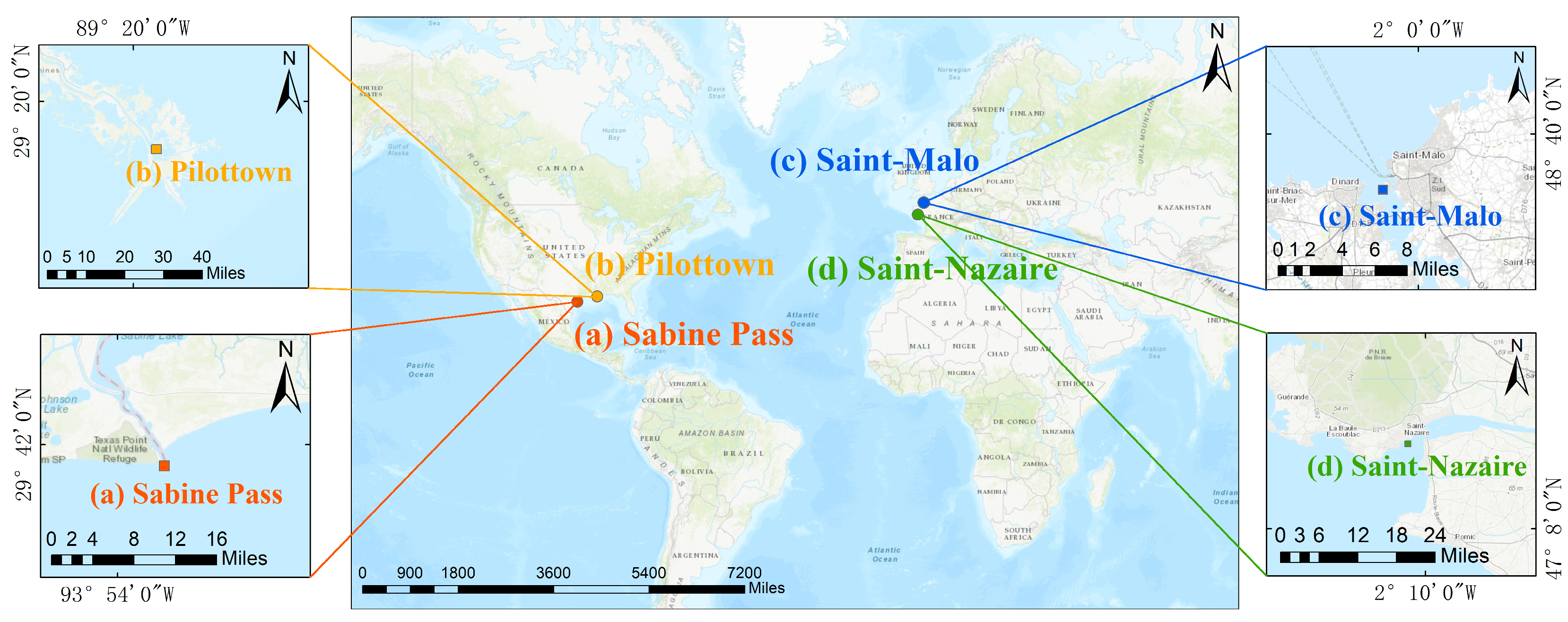
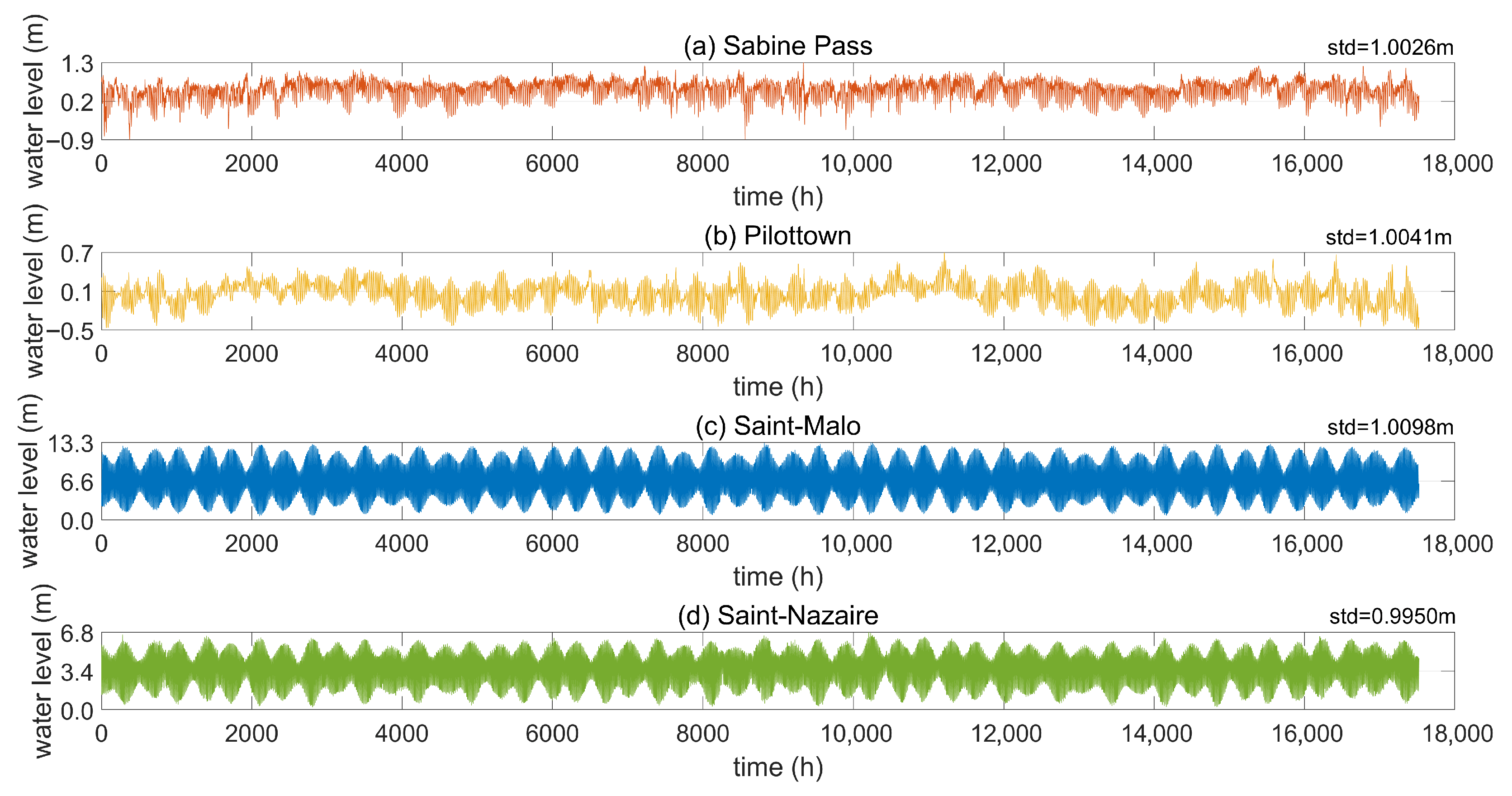
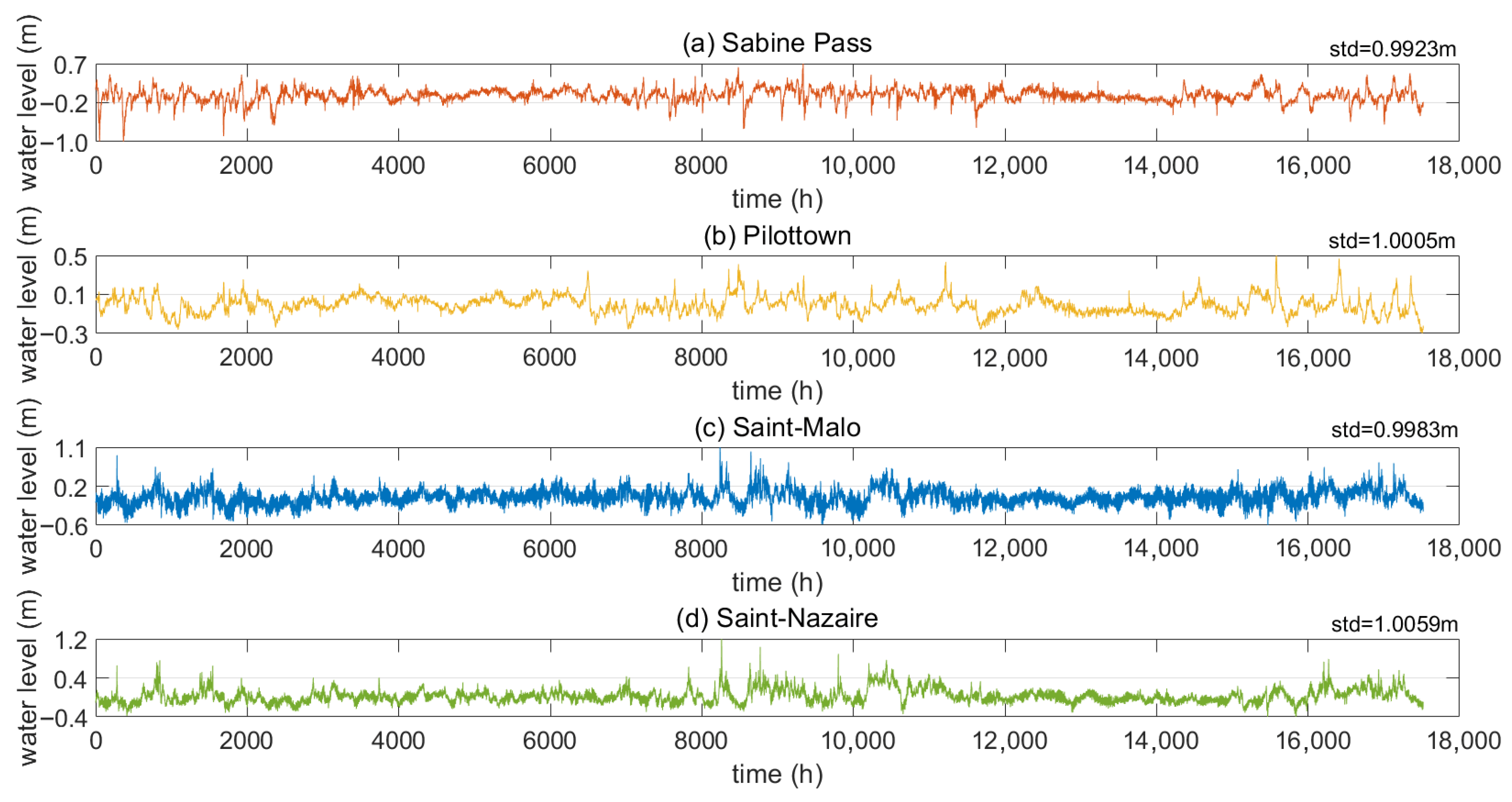
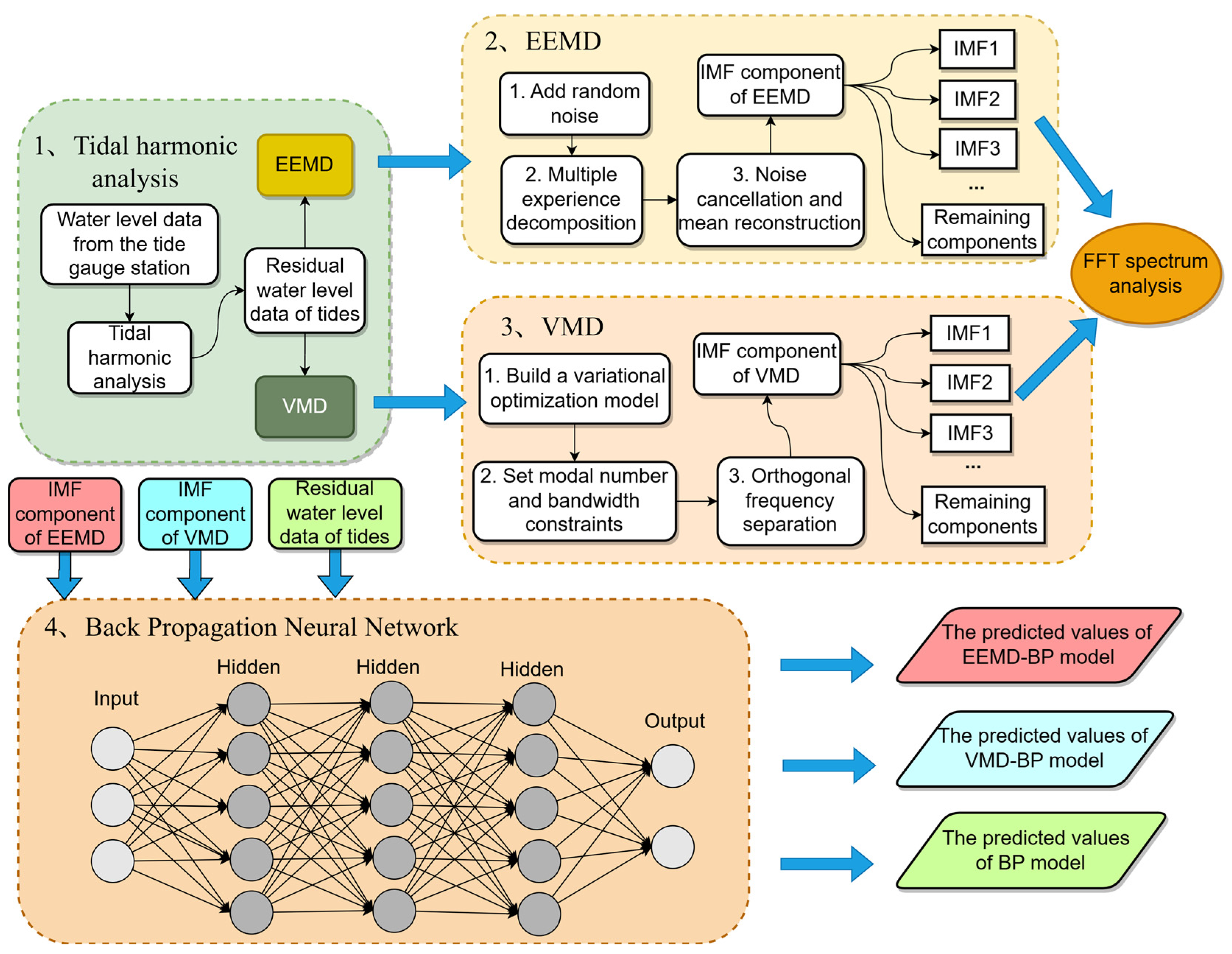
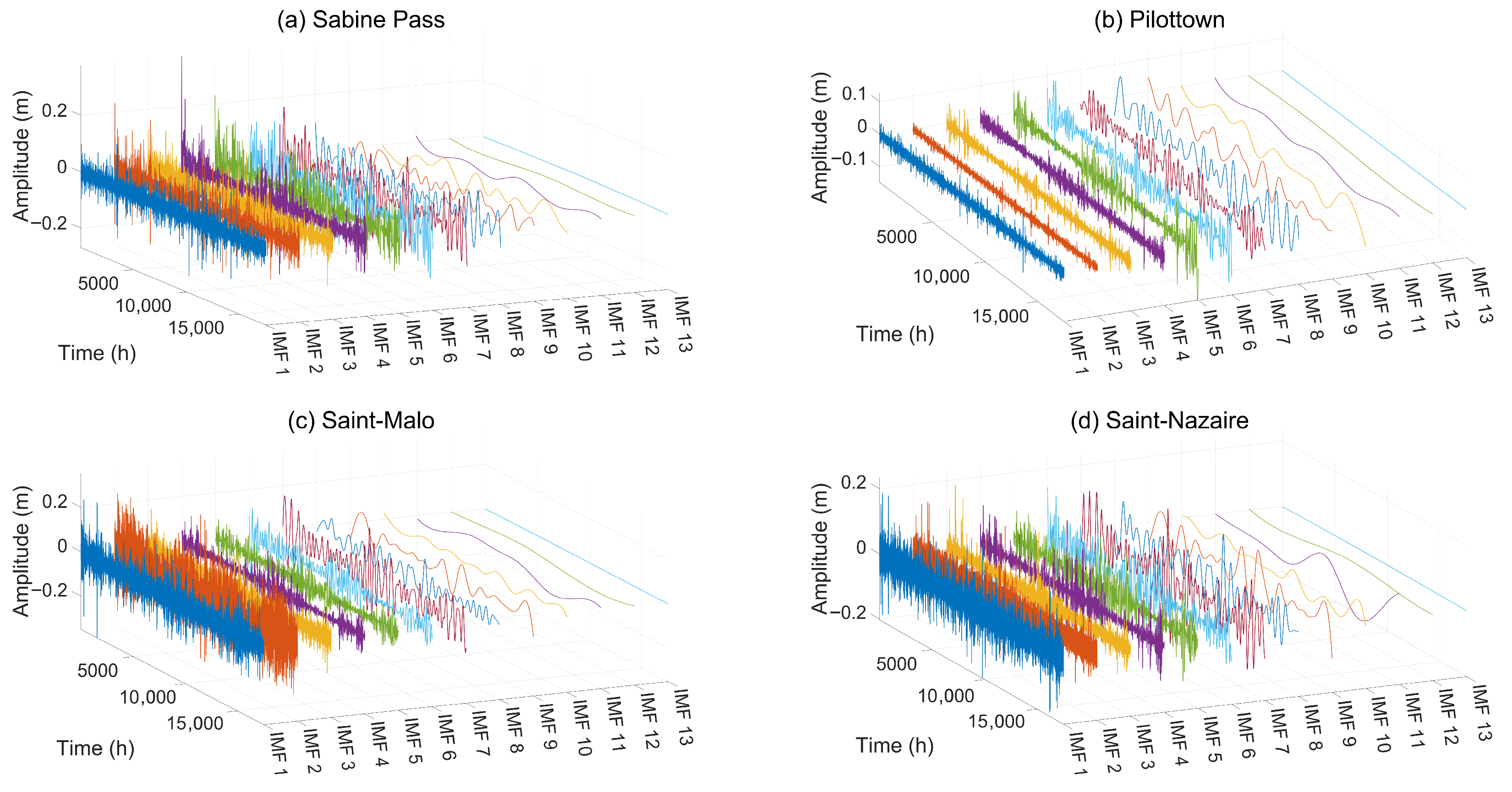

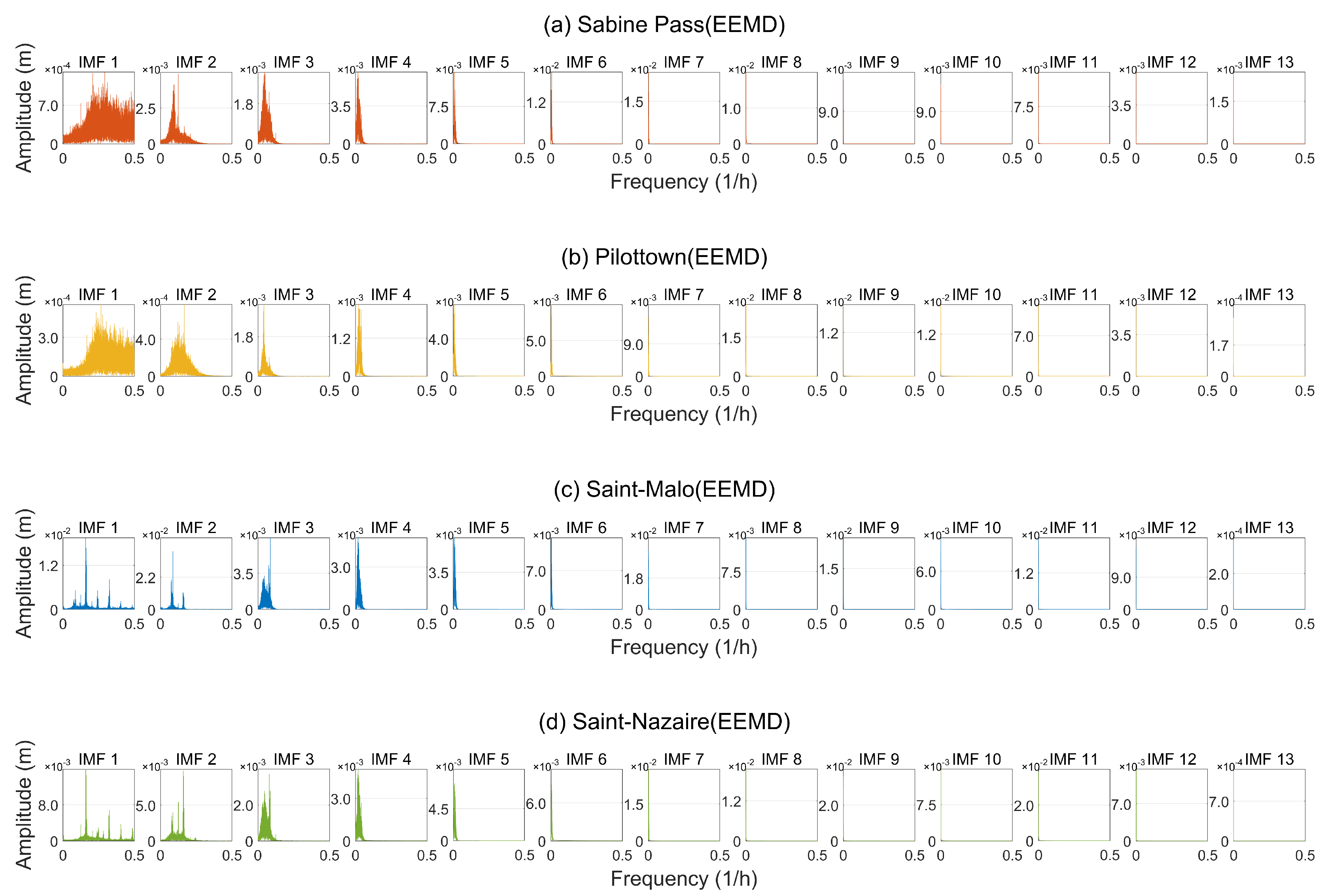
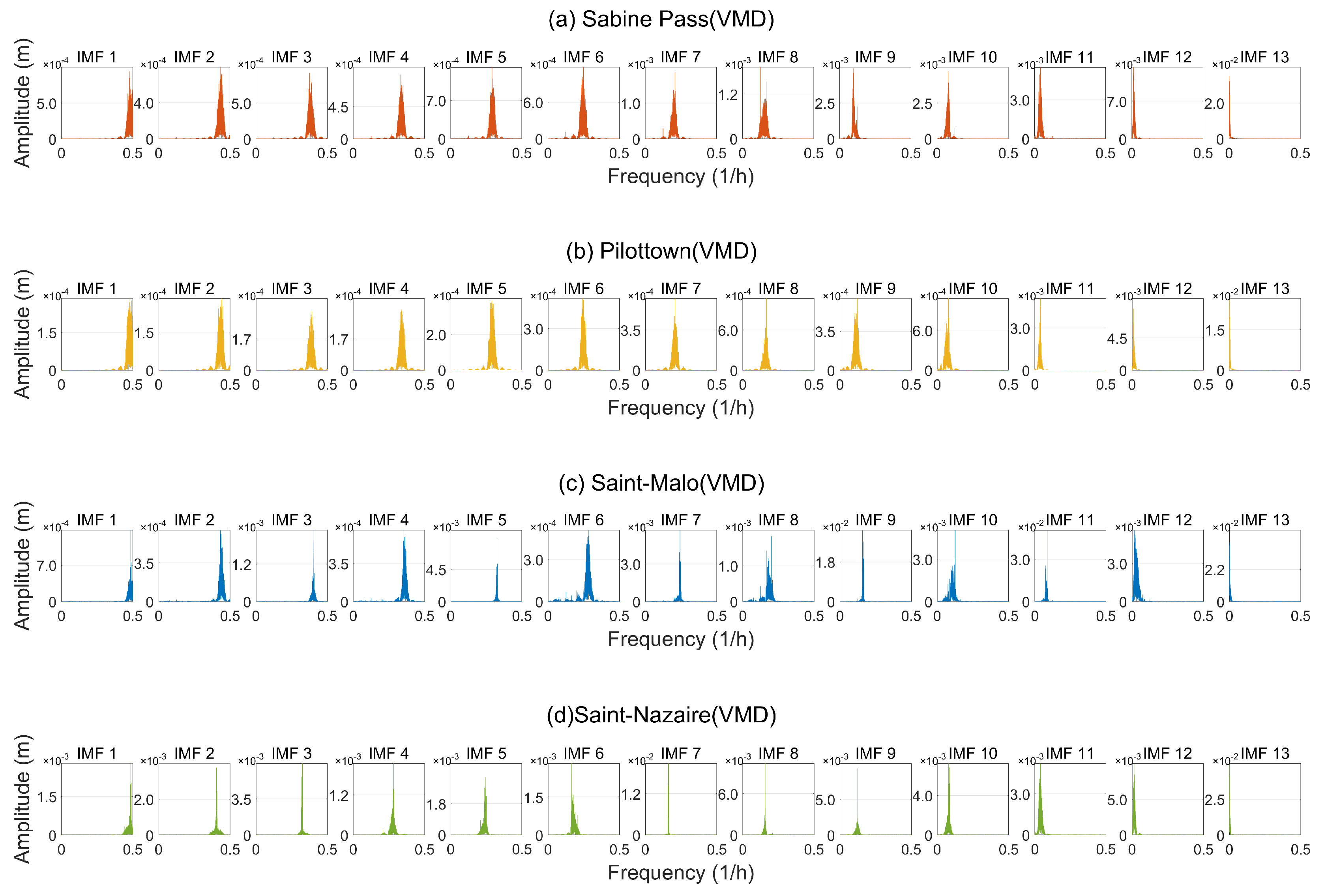

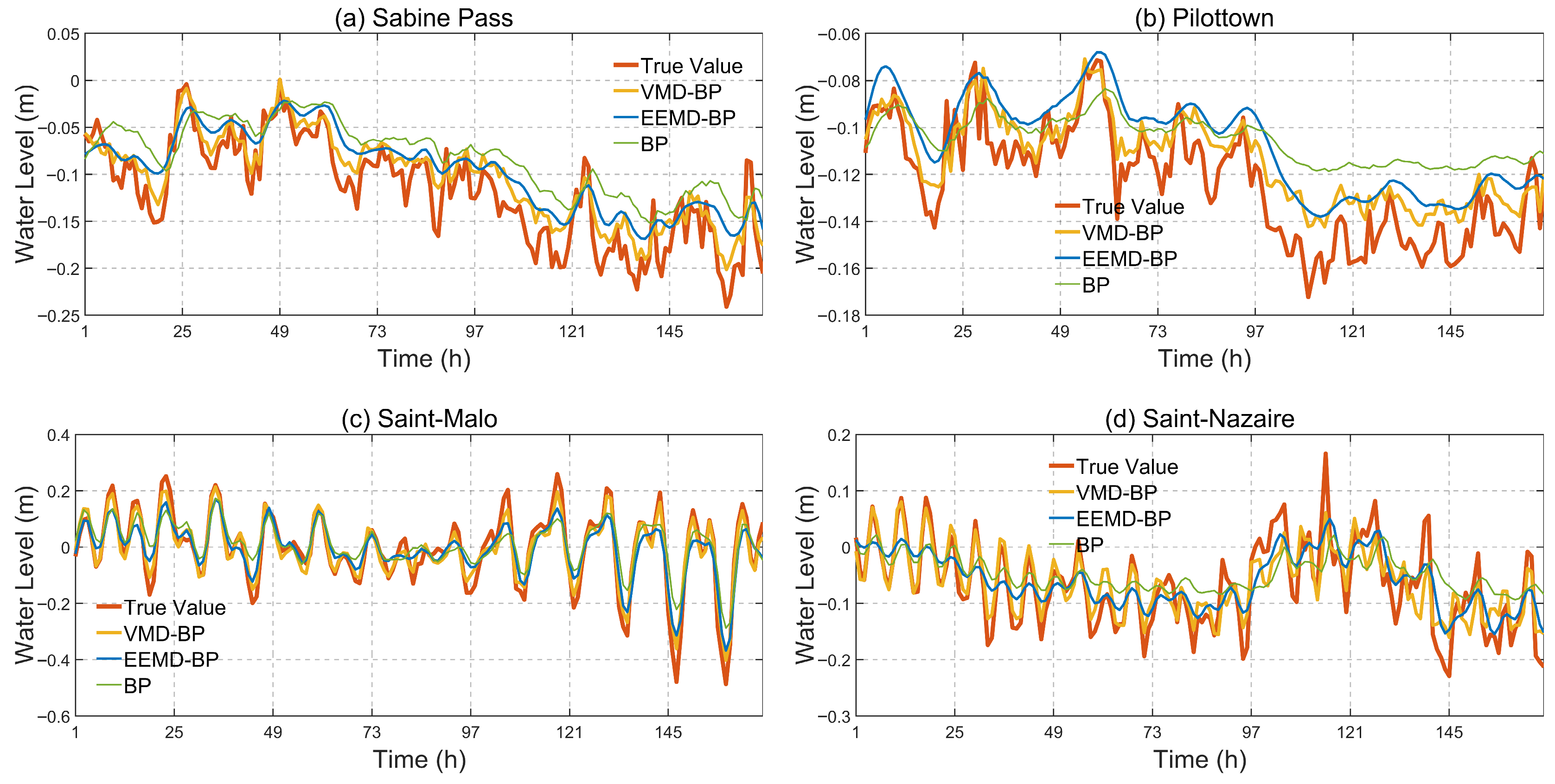

| Station Name | Time | VMD-BPNN | EEMD-BPNN | BPNN | ||||||
|---|---|---|---|---|---|---|---|---|---|---|
| RMSE | MAE | NSE | RMSE | MAE | NSE | RMSE | MAE | NSE | ||
| Sabine Pass | month | 2.95 | 2.22 | 0.9362 | 4.03 | 3.09 | 0.8810 | 5.53 | 4.34 | 0.7751 |
| week | 2.25 | 1.90 | 3.38 | 2.86 | 4.88 | 4.22 | ||||
| day | 1.95 | 1.67 | 3.01 | 2.50 | 4.60 | 4.00 | ||||
| Pilottown | month | 1.64 | 1.22 | 0.9710 | 1.86 | 1.49 | 0.9625 | 2.72 | 2.09 | 0.9199 |
| week | 1.34 | 1.14 | 1.99 | 1.77 | 2.49 | 2.13 | ||||
| day | 0.92 | 0.76 | 1.73 | 1.61 | 1.75 | 1.44 | ||||
| Saint-Malo | month | 3.19 | 2.55 | 0.9358 | 5.23 | 4.25 | 0.8276 | 6.79 | 5.45 | 0.7096 |
| week | 3.41 | 2.64 | 5.88 | 4.71 | 7.75 | 5.99 | ||||
| day | 3.27 | 2.70 | 6.17 | 4.96 | 7.82 | 6.45 | ||||
| Saint-Nazaire | month | 2.51 | 1.92 | 0.8557 | 3.86 | 3.07 | 0.6569 | 5.65 | 4.59 | 0.2660 |
| week | 3.56 | 2.79 | 4.52 | 3.66 | 6.40 | 5.12 | ||||
| day | 1.21 | 1.00 | 4.45 | 3.80 | 4.11 | 3.43 | ||||
Disclaimer/Publisher’s Note: The statements, opinions and data contained in all publications are solely those of the individual author(s) and contributor(s) and not of MDPI and/or the editor(s). MDPI and/or the editor(s) disclaim responsibility for any injury to people or property resulting from any ideas, methods, instructions or products referred to in the content. |
© 2025 by the authors. Licensee MDPI, Basel, Switzerland. This article is an open access article distributed under the terms and conditions of the Creative Commons Attribution (CC BY) license (https://creativecommons.org/licenses/by/4.0/).
Share and Cite
Zhai, M.; Cao, Q.; Huo, P.; Du, X.; Xin, M. Estuary-Tidal Residual Water Level Forecasting Method Based on Variational Mode Decomposition and Back Propagation Neural Network. J. Mar. Sci. Eng. 2025, 13, 1755. https://doi.org/10.3390/jmse13091755
Zhai M, Cao Q, Huo P, Du X, Xin M. Estuary-Tidal Residual Water Level Forecasting Method Based on Variational Mode Decomposition and Back Propagation Neural Network. Journal of Marine Science and Engineering. 2025; 13(9):1755. https://doi.org/10.3390/jmse13091755
Chicago/Turabian StyleZhai, Min, Qihang Cao, Pengfei Huo, Xintong Du, and Mingzhen Xin. 2025. "Estuary-Tidal Residual Water Level Forecasting Method Based on Variational Mode Decomposition and Back Propagation Neural Network" Journal of Marine Science and Engineering 13, no. 9: 1755. https://doi.org/10.3390/jmse13091755
APA StyleZhai, M., Cao, Q., Huo, P., Du, X., & Xin, M. (2025). Estuary-Tidal Residual Water Level Forecasting Method Based on Variational Mode Decomposition and Back Propagation Neural Network. Journal of Marine Science and Engineering, 13(9), 1755. https://doi.org/10.3390/jmse13091755





